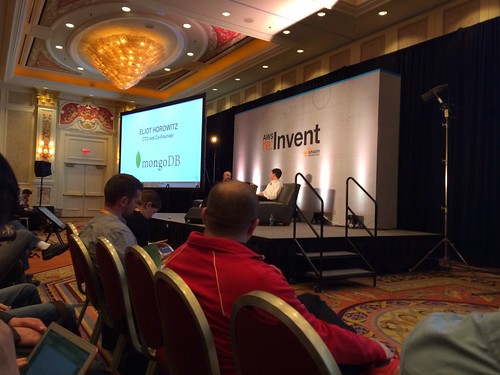TL;DR – performance improvements and two huge announcements, Docker-based EC2 Container Service and cloud-CEP-like AWS Lambda.
I was in a meeting for the first 45 minutes but I hear I didn’t miss much. Happy customer use cases.
The first big theme of this morning’s keynote is “Containers” – often just shorthand for “docker.” I went to a previous event here in town with even large enterprises and government – State of Texas, Microsoft, Dell, Red Hat – all freaking out about Docker. Docker is similar to VMWare or cloud in that it is a new technology that requires new monitoring and management just for it. (Heck, Eric, the CopperEgg founder, is now running a startup around docker container management, StackEngine.)
- Keynote from pristine.io about how they implemented. Docker, the new low overhead containerization technology, is a heavily cited part of the power (they actually used Flux7 as the expert consultants, they’re based here in Austin!).
- Keynote from Werner Vogels on the new “Amazon EC2 Container Service,” announced to cheers and applause. It allows launching and terminating containers to sets of instances on EC2. Their PM did a demo where they had a big farm of r3 servers and then they deploy a redis cluster and rabbitmq across them, and then front end components on a farm of c3s, and then audio processing across all of them. If you’re new to this it’s basically VMs within VMs but without noticeable overhead.
- Next they had the actual docker cofounder and CEO Ben Golub. He mentioned that docker is only 18 months old and its huge success and ecosystem this early in is “surreal.”
Next… Leapfrogging PaaS?
- Werner is back to announce AWS Lambda available now in preview – event-driven computing service for dynamic applications. No instance running/management required, events go in and “cloud functions” run on them. Holy shit, this replaces a large number of servers running semi-trivial apps. 20 cents per million requests, plus some complex stuff for seconds of execution – free for 3.2M seconds/1M requests.
- Netflix chief product guy came on to show how they’re using lambda as a higher level abstraction and have eliminated a bunch of servers – no system monitoring/management, no inefficient polling, no gaps/opacity. They’re using it to encode video, run backups, run security and compliance checks against instances, and for operational monitoring and dashboards. Replacing procedural control systems with event-driven services.
- AWS core innovations… New c4 instance, Haswell based (crazy fast processor, 36 vCPUs). Diane Bryant, SVP/GM Data Center Group from Intel, came on to go into the CPU specifically. Larger and faster EBS volumes, up to 20,000 IOPS. Enhanced and consistent networking speeds.
And this has been your cloud update! Also see Ben Kepes in Forbes for a similar summary.
The container engine is cool – it’ll certainly remove a lot of instance gerrymandering and instance reservation pain if nothing else. But Lambda is the potential disruptor here. It’s taking the idea of “bring your own algorithm” from MapReduce and saying “hmmm you can probably replace your trivial web app just with this” – it’s halfway between a PaaS and a SaaS, none of the Beanstalk complexity, just “here take this function and run it on stuff when it comes in.” If a library of common lambas becomes available, so much computing work done for trivial purposes becomes obsoleted. Who hasn’t seen a Web service to “upload a file here, then zip it or something, then store it…” OK, no servers needed any more. Very interesting.















